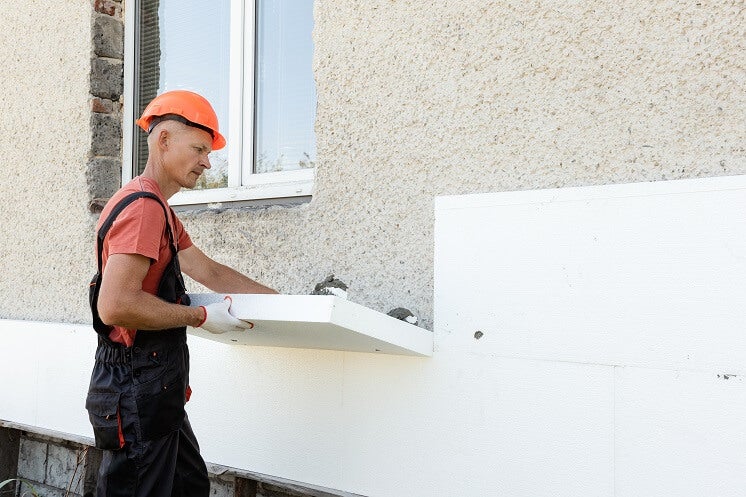External wall insulation, especially in solid-walled houses, is one of the most effective methods of preventing losses of heat and saving energy. Although only 30% of homes in the UK have solid walls, around 90% of these still remain uninsulated.
For anyone looking for energy efficiency, external wall insulation can save hundreds of pounds per year in energy bills, aside from reducing carbon emissions. While the average cost for a 3-bedroom semi-detached house reaches up to £11,000, grants like ECO4 and The Great British Insulation Scheme(GBIS) can make this investment quite affordable.
This blog will review factors related to the variation in external wall insulation costs, the benefits associated with it, and what insulation grants are available for them.
What is External Wall Insulation?
External wall insulation involves adding insulation material from the outside to the walls of your house, the most common types being expanded polystyrene (EPS), mineral wool, or even cork. This insulation is then normally finished with a protective render or cladding that raises not only the energy efficiency of your home but also its appearance and weather resistance.
This is particularly effective in homes with solid walls – a common feature of properties built before the 1920s. It reduces heat loss, thus lowers energy bills, and improves comfort, and increases the overall value of your property.
How Does Exterior Wall Insulation Work?
External Wall Insulation (EWI) works by decreasing the heat loss from your home by adding a layer of protection to the outside of your walls. In order to delve into how it works, it’s important to know the main ways in which heat escapes a building:
- Conduction: This is the direct heat passing through materials, such as walls. The insulation material used in EWI is a poor conductor of heat; thus, it keeps the warmth inside your house.
- Convection: The heat can transfer in the air within the wall structure. EWI materials physically trap air in small pockets – which reduces this movement in heat. Thus, it does not let the warmth out.
- Radiation: Heat is lost through radiation at the surface. In EWI materials, minimum radiant energy is absorbed, and hence, further reduction in heat loss takes place.
How Much Does External Wall Insulation Cost?
The cost of external wall insulation depends upon a number of controlling factors, but you can expect to pay about £11,000 on average for a semi-detached, 3-bedroom house.
The complete cost depends on the size of your house, materials employed, complexity of installation, and finishing options.
For example, the Royal Institution of Chartered Surveyors estimates nearly £13,000, but the Energy Saving Trust puts a slightly lower estimate at £12,000 for a complete job.
External Wall Insulation per Square Metre Cost
The external wall insulation typically costs between £100 and £250 per square metre. Prices may tend to vary as per the detail of a job – for example, relative size and complexity.
The estimates of the external wall insulation cost, depending on the different types of homes, have been given in the table below:
| Home Type | Lower Cost Estimate (inc. VAT) | Higher Cost Estimate (inc. VAT) | Average Cost |
| Detached | £15,000 | £25,000 | £17,500 |
| Semi-Detached | £8,000 | £15,000 | £9,000 |
| Mid-Terrace | £5,000 | £10,000 | £7,000 |
Factors Influencing External Wall Insulation Costs
The cost of external wall insulation depends on the following:
-
Type of Walls
The type is very important: most houses built after 1920 tend to have cavity walls, the insulation of which is faster and less expensive; before 1920, though, most houses were built with solid walls, which lose more heat and are more costly to insulate.
-
Internal versus External Insulation
Solid walls can be either internally or externally insulated. External insulation involves attaching a layer of insulation material to the external side of your wall before protecting it with render or cladding. Internal insulation is generally cheaper but will reduce room sizes.
-
Insulation Materials
The cost will also vary with the type of insulation materials selected. Choices range from EPS to mineral wool to cork, among others, and they also range in cost and performance. Better quality or eco-friendly materials cost more but insulate much better and last longer.
| Material | Average cost per m2 |
| EPS boards | £10 |
| PIR boards | £12.50 |
| Mineral (Rock) wool | £18.20 |
| Woodfibre | £19 |
| Cork board | £19.50 |
| XPS boards | £21.50 |
-
Need for Scaffolding
Scaffolding is usually required so as to offer external wall insulation, especially for multi-storey homes.
Calculating Costs for External Wall Insulation
Several factors come into play when estimating the cost of external wall insulation:
- Base Rate: It is approximately £100 per square metre of a wall.
- Choice of Material: Different insulation materials vary in price, with higher-quality options generally costing more.
- Wall Size: Larger walls equate to more material. Both insulation and finishing are going to be very expensive.
- Other Modifications: The costs may be higher depending on whether one needs to make adjustments in external features such as pipes or even vents.
FOR INFORMATIVE CONTENT VISIT.. : Corporate Gifts
External Wall Insulation Grants
In support of Carbon Net Zero by 2050, two key grant schemes – GBIS and ECO4 – are available up to March 2026.
These schemes target fuel-poor and energy-inefficient households across the UK, offering various incentives – for example, wall insulation grants – to improve homes with the eventual aim of reducing the carbon footprint of domestic properties in general.
The external wall insulation grants include:
The Great British Insulation Scheme (GBIS)
Introduced in March 2023, the Great British Insulation Scheme (GBIS) replaced ECO+, targeted at homes that do not qualify for the ECO4 scheme and will specifically be used for energy efficiency improvements.
This £1 billion scheme is expected to help approximately 300,000 UK households in reducing fuel poverty and carbon emissions by providing single insulation measures, such as solid or cavity wall insulation and loft insulation.
The application process can be done through the UK government portal, where a home assessment will determine the most effective insulation measure.
The ECO4 Scheme
The ECO4 Scheme works differently: it works by obliging energy companies to help qualifying households regarding various upgrades directly, including internal and external wall insulation grants.
This is rather more far-reaching and provides multiple measures that might be fitted to improve your home’s energy efficiency greatly.
Are You Eligible for Insulation Grants?
The eligibility criteria for insulation grants include:
- Energy Performance Certificate (EPC) Ratings
Your home must have an EPC rating between D and G to qualify for GBIS. The EPC is the rating of energy efficiency in a property. D, E, F, and G ratings are less efficient than others.
- Residency
The applicant must be a homeowner or a private tenant in England, Scotland, or Wales to apply for the insulation grant. Households in social housing can receive qualification under certain conditions.
- Income Criteria
The grants often target lower-income families or those with specific benefits. Generally, households that have an income of £20,000 per year or less are typically targeted for insulation grants.
- Property Age
It has to be over a certain threshold, usually at least 10 years old or over, for qualification in order to get insulation grants. This might vary with different grant schemes.
- Existing Insulation
Eligibility may also relate to the level of insulation in your home. Houses with little or no previous insulation are prioritised.
- Government Benefits
Receiving certain government benefits will increase your eligibility for wall insulation and will make eligibility easier under the ECO4 scheme for grants.
What Is External Wall Insulation Made Up Of?
External wall insulation systems are composed of several layers, each acting to maximise their effectiveness:
- Primer: Applied before installing insulation, this gives a kind of waterproofing effect that protects the insulation layer from dampness, hence increasing the efficiency.
- Insulation Layer: This forms the core component, usually produced using various materials such as expanded polystyrene, mineral wool, and phenolic boards. These materials prevent heat leakage via the walls.
- Glass Fibre Mesh & Fixing Anchors: This is laid onto the insulation layer, which is fixed in such a way that it does not disrupt it during the drying process of the primer.
- Render Finish: The final layer is the render that provides a protective and decorative finish. It can be customised to match the appearance of your home and adds that extra layer of protection against weather conditions.
Common Materials for External Insulation
- Polyisocyanurate (PIR) Boards
- Extruded Polystyrene (XPS) Boards
- Expanded Polystyrene (EPS) Boards
- Mineral Wool (Rock Wool)
- Woodfibre
- Cork Boards
Best External Wall Insulation Materials
Your budget, thermal efficiency, breathability, sustainability, and durability are all important factors in the selection of the best external wall insulation. The following is a guide to selecting appropriate materials depending on your needs:
Best for Budget
Expanded Polystyrene Boards
EPS boards are an affordable solution, averaging at about £10 per square metre. Offering a decent R-value, they can be acquired at so much more reasonable costs relative to their counterparts. While they are not the most ‘green’ product available, they are light and also easy to put in, which makes them quite practical for local projects and budgets.
Best for Breathability
Wood Fibre Insulation
Wood fibre insulation is extremely breathable. For this reason, it allows moisture to get out and does not allow dampness to build up. It works well in older buildings that have stone walls. It is also environmentally friendly, and it has the plus point of burning slowly.
Best for Thermal Efficiency
Polyisocyanurate (PIR) Boards
PIR boards have high efficiency and are considered one of the finest choices for thermal insulation. Besides, they don’t burn easily and are relatively easy to install. Their R-value goes down when the temperature decreases significantly. The boards are prone to water absorption; therefore, a good water barrier and waterproofing are essential.
Best for Sustainability
Cork Boards
Cork is collected without cutting any trees, and the material itself is biodegradable and recyclable. They tend to provide a much stronger thermal efficiency compared to wood fibre. With its being a natural material, cork boards please all natural lovers. Cork boards have fire and water resistance, making them a great eco-friendly insulation material.
Best for Durability
Extruded Polystyrene (XPS) Boards
Because of its stability over time and due to its high compressive strength, XPS is suitable for mechanically strained areas. It has very low moisture absorption and can last as long as 50 years and even more by using appropriate installation techniques.
Long-Term Benefits of External Wall Insulation
External wall insulation provides several long-term advantages that make the investment worth the cost to a homeowner:
Improved Thermal Performance: This is achieved by reducing heat loss through walls to give a warmer home while also reducing energy bills.
Reduced Carbon Footprint: By reducing the heating needs, it contributes to lower carbon emissions and supports the UK’s Net Zero goal.
Lower Energy Bills: Effective insulation can lead to savings on heating costs, up to 40%, by preventing heat from escaping through uninsulated walls.
Noise Reduction: It acts like a sound barrier, reducing the noise from the outside and helping to make the living area quieter.
Prevents Condensation and Damp: Insulation prevents the entry of cold inside by trapping the heat, reducing condensation and dampness issues.
Minimal Disruption: Installation is done from the outside, hence causing a little disturbance to your home while keeping your interior space intact.
Increased Comfort: It keeps the indoor temperature regular, thus increasing the comfort level throughout your home.
Improved Aesthetics: It improves the appearance of your house with different finishes, both decorative and protective, besides protection against weather conditions.
Building Regulations for External Insulation
Depending on the building type, external wall insulation will be subject to different building regulations. Understanding these is important for ensuring a compliant project. Key considerations include:
- Thickness: The insulation thickness should fall between 50-100 mm because this will satisfy the building’s needs without exceeding the maximum U-value.
- Structural Integrity: Check if your building is strong enough to support the additional weight caused by insulation and cladding.
- U-value: The insulation must be able to achieve a U-value of 0.30 W/m²K or less.
- Moisture Control: Insulation should be installed with the incorporation of moisture control measures. That would help in preventing dampness and growth of mould. There needs to be adequate ventilation.
- Fire Safety: Ensure that the insulation material meets UK fire safety standards.
Does External Wall Insulation Require Planning Permission?
Knowing whether or not planning permission is needed because of the reasons for carrying out external wall insulation on your home is paramount. Generally, you will not need planning permission to install EWI, but there are some exceptions:
- Your property could be in a conservation area. This is an area with restrictions upon changing the appearance of the building, so you may require planning permission for work.
- All works to listed buildings, including external insulation, require Listed Building Consent.
- Compliance with building regulations is necessary to ensure the insulation meets energy efficiency standards.
- You may need planning consideration if the insulation will alter the external appearance.
- Changes may require planning permission, which has a broad effect on the entire building.
- If an EWI does not affect the external appearance of the property, planning permission is not usually needed.
Mistakes to Avoid When Installing External Wall Insulation
- Choice of the wrong type of insulation
- Improper installation
- Failing to prepare the surface properly
- Ignoring building codes and regulations
- Not hiring a qualified professional
- Focusing only on the external insulation cost
The Bottom Line
External wall insulation is a valuable investment for better energy efficiency, reduced heat loss, and saving on energy bills. The initial costs of external wall insulation differ since costs depend on things like the type of material or wall size. Long-term savings from energy, however, add to the comfort factor.
You get a warmer home with a smaller carbon footprint and greater value by selecting appropriate insulation and ensuring its correct installation.
Frequently Asked Questions
Is external wall insulation worth it?
Yes, it is worth the investment. External wall insulation advances the energy efficiency of your house by reducing heat loss and eventually reducing energy bills. It could also raise the value of your property and make it more comfortable.
How long does external insulation last?
It can be a long-term and sustainable option, which would probably last up to 30 years or even longer with very little maintenance.
Do I need planning permission to install EWI?
If your property is a listed building or is in a conservation area, then you will be required to obtain Planning Permission from your local authority.





